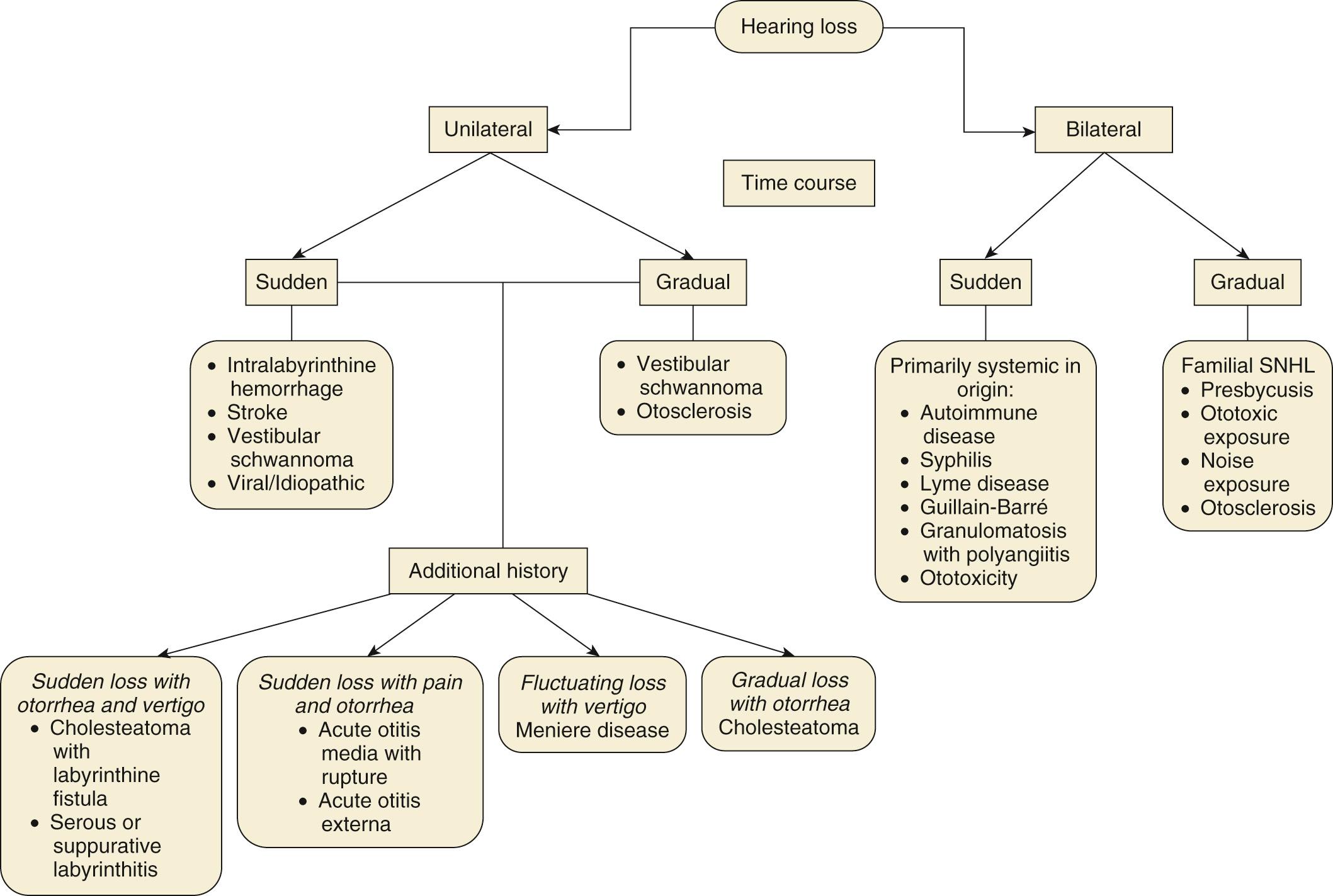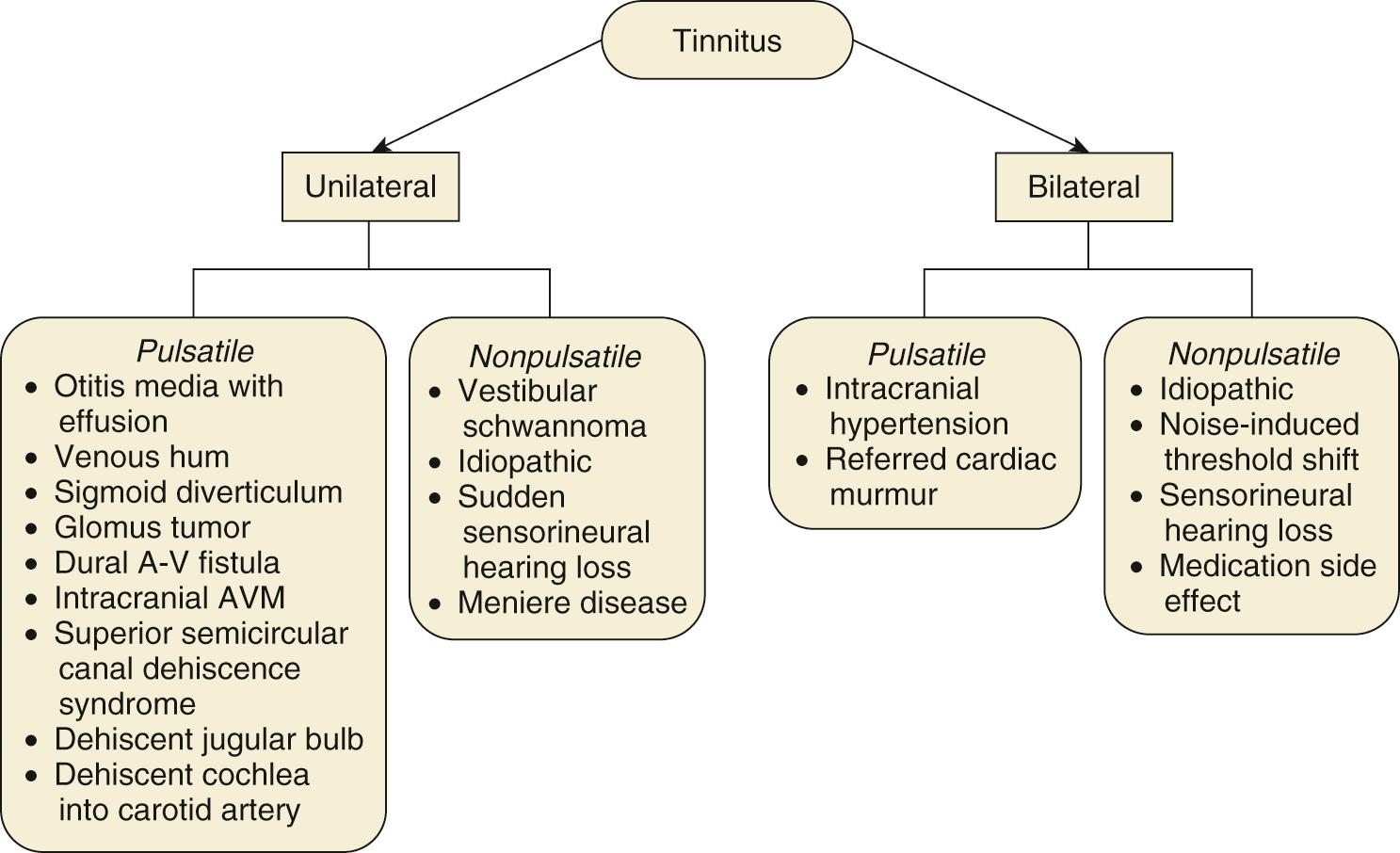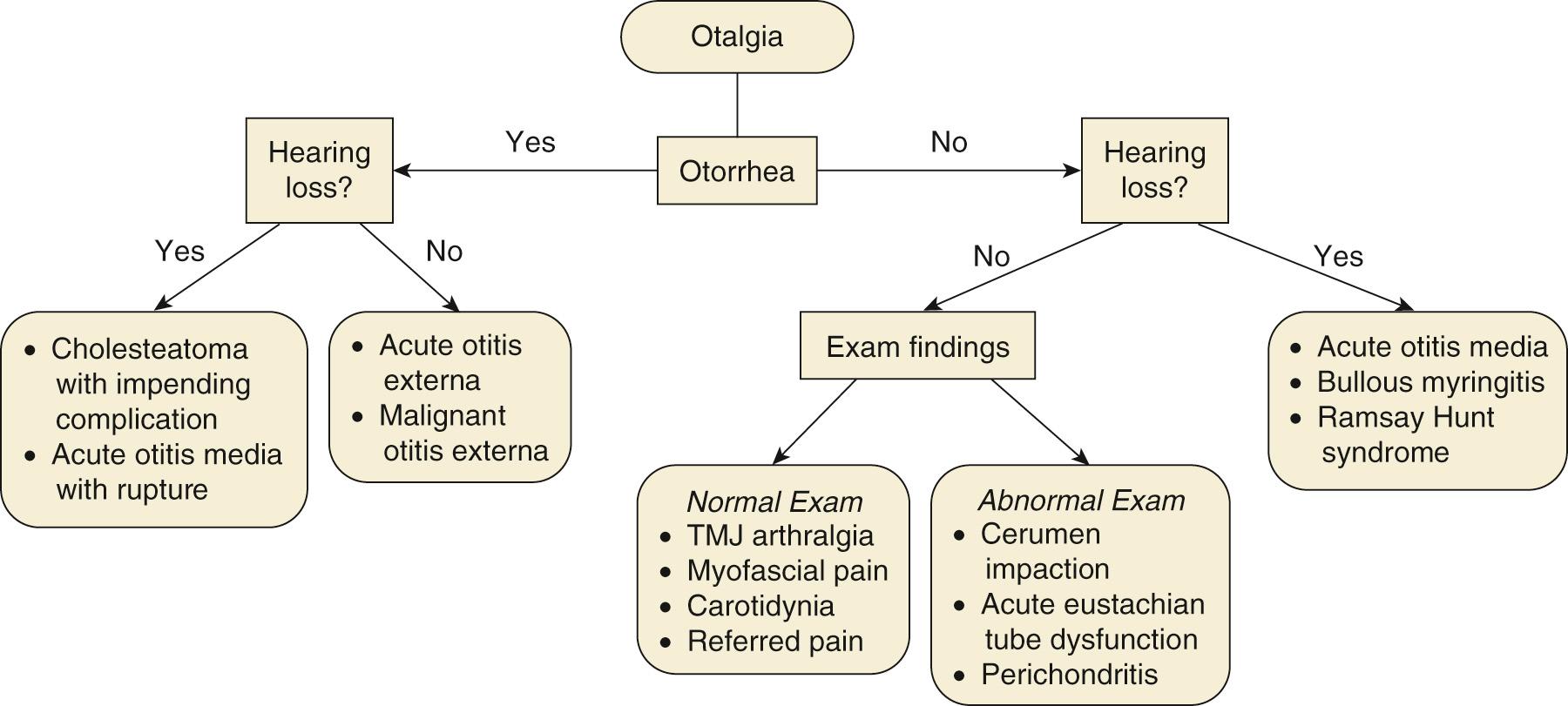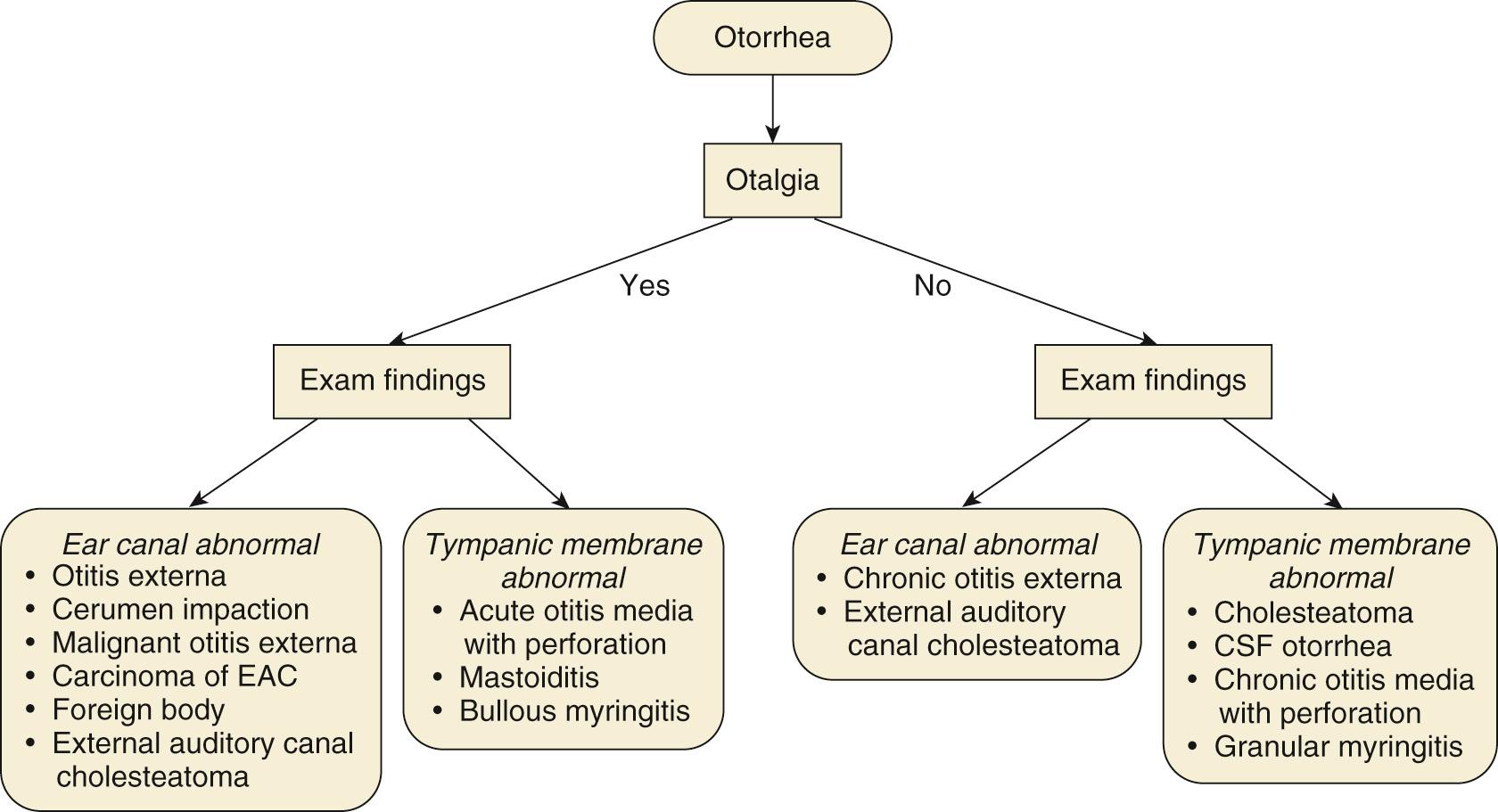Physical Address
304 North Cardinal St.
Dorchester Center, MA 02124
Hearing loss, tinnitus, otalgia, otorrhea, and vertigo are symptoms of otologic disease. Queries into each of these symptom categories will assist the clinician in formulating a differential diagnosis.
Taking a comprehensive history is critical for establishing a diagnosis for vertigo symptoms. Importantly, symptoms such as headache, visual aura, photophobia, phonophobia, extremity weakness or numbness, or other cranial nerve deficits suggest central and not peripheral etiology.
Unilateral tinnitus or hearing loss should be further evaluated with MRI to rule out retrocochlear pathology.
Pulsatile tinnitus may represent a benign flow murmur but more serious cerebrovascular lesions or paraganglioma should be ruled out.
Otalgia can represent ear disease or may be referred from elsewhere in the head and neck. Red flags for otalgia include: hoarseness, dysphagia, neck mass, weight loss, and social risk factors (tobacco and/or alcohol abuse). These concurrent symptoms require assessment of the upper aerodigestive tract to rule out head and neck malignancy.
Clinical exam of the patient with otologic complaints should include a careful otologic exam, full cranial nerve exam, and tuning fork exam.
High-volume otorrhea should raise suspicion of cerebrospinal fluid leak and warrants further evaluation.
The Romberg test does not localize a lesion. It may be positive (fall) in both central and peripheral causes of dizziness/imbalance.
Myriad clinical syndromes feature hearing loss and/or labyrinthine dysfunction. Familiarity with these syndromes will allow recognition of these rare clinical patterns when present.
Assessment of the patient with otologic complaints requires careful history taking in addition to a focused clinical exam. Many otologic complaints can be diagnosed by history alone, with the clinical exam frequently supporting the expected findings.
Consider organizing a line of inquiry around five components of otologic symptoms in every patient: hearing loss, tinnitus, otalgia, otorrhea, and vertigo. Follow through with questions about occupational history, family history, surgical history and coexisting medical conditions to complete a comprehensive history.
Hearing loss is one of the most common reasons for presentation to the otolaryngologist. Although patients may be referred from audiologists (and come with audiogram in hand), the otolaryngologist frequently represents the initial contact point for the patient complaining of hearing loss. Table 137.1 lists possible questions that the examiner should posit to the patient.
| Duration | What difficulty is this causing the individual? |
| Progression | Prior ear infection/trauma/surgery |
| Slow versus rapid | Noise exposure |
| Sudden | Family history of hearing loss |
| Fluctuating | Ototoxic medication exposure |
| Symmetric or asymmetric? | Prior amplification experience |
| Associated ear symptoms | |
| Tinnitus | |
| Vertigo | |
| Otalgia | |
| Otorrhea |
Hearing loss may be conductive (CHL), sensorineural (SNHL) or mixed (MHL). Although examination and audiometric testing are confirmatory, there are several historic components which may suggest CHL. Hyperacusis of Willis is a phenomenon of CHL in which the patient claims to hear better in background noise, such as a cocktail party. Autophony may also suggest CHL, although it does not define cause. A personal history of ear infection/trauma/or surgery could cause CHL through ossicular discontinuity or fixation. Otosclerosis ( Chapter 146 ) is a condition which frequently presents with CHL secondary to stapedial fixation. Patients may present with unilateral or bilateral progressive hearing loss without a significant otologic history. In such a case, family history may reveal relatives who had surgery for loss of hearing.
Sensorineural hearing loss (SNHL) may occur at any age. The age of the patient should define the line of questioning. For children, prenatal and birth history, as well as family history, may suggest ototoxicity, prenatal infection ( Chapter 193 ), auditory neuropathy (AN section in Chapter 134 ), or genetic hearing loss of syndromic or nonsyndromic nature ( Chapter 150 ). Post-lingual or adult-onset SNHL has a wide range of etiologies that may be evaluated by a combination of careful history, exam, audiometric testing, and occasionally imaging. Family history is important in adults as well; many patients may have a genetic predisposition to hearing loss. A history of noise exposure, whether occupational or recreational, is also important to elicit. Many patients with noise-induced SNHL ( Chapter 154 ) will complain of the significant effort needed to understand speech. This difficulty is a result of the loss of mid- and high-frequency sounds with relative preservation of the low frequencies; the patient will say that they can hear, but cannot understand, what people are saying.
Fig. 137.1 outlines a simple algorithm for evaluating a patient with hearing loss. Table 137.2 lists red flags in the hearing loss history. These qualities should prompt the clinician to evaluate further for an etiology of the patient's hearing loss complaint. These features suggest that the hearing loss may be a symptom of a more concerning problem, such as an ear or skull base lesion, cerebrovascular event, or a time-sensitive issue like sudden SNHL ( Chapter 152 ).

| Unilateral | Otalgia |
| Sudden onset | Accompanying cranial nerve signs |
| Fluctuation | Numbness |
| Rapidly progressive | Diplopia |
| Vertigo or ataxia | Facial paresis |
| Otorrhea | Voice/swallowing changes |
Tinnitus ( Chapter 153 ) may be the chief complaint of the patient or an incidental symptom uncovered during questioning. Table 137.3 lists possible questions that the examiner could posit to the patient. The clinician should thoroughly explore the symptom of tinnitus, and then delve into each of the other categories of otologic complaints. This strategy is outlined in Fig. 137.2 and will allow the clinician to develop a differential diagnosis.
| Duration | Associated ear symptoms |
| Progression | Vertigo |
| Slow versus rapid | Hearing loss |
| Sudden | Otalgia |
| Fluctuating | Otorrhea |
| Symmetric or asymmetric? | Prior ear infection/trauma/surgery |
| Pulsatile or non-pulsatile? | Noise exposure |
| How does it sound? | Family history of hearing loss |
| Mitigating factors | Caffeine or other stimulant consumption |
| Prior therapies |

It is specifically important to the tinnitus sufferer to evaluate their state of mind. Patients may come in very emotionally distressed by their tinnitus, occasionally with suicidal intent. It is a moral imperative for the clinician to assess the patient for the risk of self-harm during the clinical visit. Additional exacerbating conditions such as poor sleep quality and significant situational stress (such as work environment or familial strife) should be queried.
As there are many modalities of professional and self-help available to the patient, one should establish what the patient has tried for tinnitus relief prior to the encounter. These interventions could include dietary supplements, chiropractic manipulation, acupuncture, sound therapy, ambient noises, dietary changes, sound deprivation, hearing amplification, cognitive behavioral therapy, psychoactive medications, and substances with the potential for abuse such as alcohol or benzodiazepines.
Pulsatile tinnitus (Subsection in Chapter 153 ) requires a very different line of inquiry than nonpulsatile tinnitus. The origin may be completely benign but could also be the harbinger of a serious cerebrovascular problem. Neurologic symptoms should be elicited, such as headaches, vision changes, and cranial nerve (CN) changes, as well as symptoms of stroke such as aphasia and face/body weakness now or in the past. Cardiac and vascular history should be elicited. Vertigo, hyperacusis, and other autophonies should be queried. Prior head or neck trauma should also be reviewed.
A proper assessment of ear pain must include a thorough inquiry of the pain characteristics and associated symptoms. See Table 137.3 for example questions to ask the patient. Understanding the relationship of otalgia and ear fullness to other otologic symptoms can differentiate between primary otologic disease and referred otalgia ( Fig. 137.3 ). Pain may be characterized as acute and chronic, as well as nociceptive (due to damaged tissue and responding nociceptors) or neuropathic (originating from nerve damage and/or abnormal nerve signals).

Primary otalgia is frequently accompanied by hearing loss and otorrhea. The combination of these symptoms may indicate common self-limited disease such as otitis media or externa. These disorders, as well as more serious causes such as primary otologic malignancy ( Chapter 172 ), mastoiditis ( Chapter 140 ), cholesteatoma ( Chapter 140 ), or skull base osteomyelitis (malignant otitis externa) ( Chapter 138 ), can be further evaluated by physical exam.
Otalgia may be referred from numerous sources, because of the anatomic complexity of the head and neck. A most common source of referred otalgia is dental. This may include primary dental disease (such as periodontal disease, caries, and dental abscesses) or conditions relating to the temporomandibular joint ( Chapter 89 ), such as bruxism, clenching, primary temporomandibular joint osteoarthritis, or musculoskeletal pain from the muscles of mastication.
Head and neck malignancy is another potential source of referred otalgia, and it is critical that this not be missed by the clinician. Hearing loss or otorrhea is likely not present. However, additional symptoms of voice or swallowing changes, weight loss, shortness of breath, oral lesions, or masses in the neck should alert the clinician of a possible head and neck malignancy. Social history cues such as tobacco and alcohol abuse should also signal to the clinician to look beyond the ear to rule out a malignancy. In such circumstances, attention should then be directed at a full evaluation of the upper aerodigestive tract, as well as the salivary glands and neck.
Chronic ear pain may be more difficult for the patient to describe, and as such, the patient may have a complex history of this pain over time. Chronic pain may be classified as neuropathic, nociceptive or both. Chronic pain conditions such as post-herpetic neuralgia, fibromyalgia, and reflex sympathetic dystrophy could be suggested by the patient's past and current medical history. Psychological stressors should be explored. Prior therapeutic interventions should be comprehensively reviewed, especially opioid use.
Ear fullness is a vague descriptor for a sensation that could be originating in or outside of the ear. Patients may describe a sensation of pressure and may say “if I could just pop my ear it would be better.” Other patients may describe a sensation of being underwater or a “clogged” feeling. The clinician should evaluate for hidden hearing loss, eustachian tube dysfunction, chronic otitis media, and temporomandibular joint dysfunction (also see Chapter 131 ).
Otorrhea, or drainage from the ear, suggests a primary otologic pathology. Table 137.4 outlines questions to ask the patient presenting with otorrhea. Fig. 137.4 presents a flowchart to assist the clinician in considering differential diagnoses.
| Onset: Timing; context | Associated ear symptoms |
| Pain scale 1–10 | Vertigo |
| Presence: Continuous vs intermittent | Hearing loss Otalgia Otorrhea Prior ear infection/trauma/surgery Prior head and neck infection/surgery/radiation |
| Symmetric or asymmetric | |
| Qualities: Stabbing; dull; burning | |
| Exacerbating factors | |
| Mitigating factors | |
| Masses in mouth/throat/neck | Tobacco use |
| Voice/swallowing changes | Alcohol use |
| Weight loss |

Acute otitis externa (Subsection in Chapter 138 ) is the most common cause of otorrhea and should be easily confirmed by physical exam. Physical exam may instead reveal otitis media, which may be acute or chronic drainage via ventilation tube or perforated tympanic membrane (TM). Chronic painless otorrhea should raise one's clinical suspicion for cholesteatoma (Subsection in Chapter 140 ). Sometimes, chronic otorrhea may be secondary to chronic otitis externa (Subsection of Chapter 138 ). Moisture from de-epithelialized regions of the ear canal or TM may also accumulate and occasionally drain. The appearance of mucosa-like areas or myringitis should be sought in the setting of an intact TM or dry perforation.
Cerebrospinal fluid (CSF) otorrhea ( Chapter 178 ) has a distinct presentation. It is clear and copious. The patient may report prior head trauma or temporal craniotomy, but it may also occur spontaneously. CSF otorrhea may occur during activities or positions which raise intracranial pressure such as the Valsalva maneuver. CSF otorrhea should be ruled out in any patient having copious watery otorrhea after ventilation tube placement or any patient with a pulsatile clear copious otorrhea at the time of tube placement. If it is feasible to collect the otorrhea, it should be tested for beta-transferrin. The middle fossa floor should be examined for the location of the leak via high-resolution CT of the temporal bone.
Become a Clinical Tree membership for Full access and enjoy Unlimited articles
If you are a member. Log in here